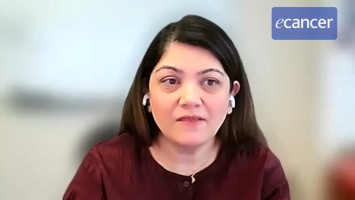ASCEMBL: Asciminib for hard-to-treat chronic myeloid leukaemia
Prof Andreas Hochhaus - Universitätsklinikum Jena, Jena, Germany
We presented the ASCEMBL study which is a randomised phase III study investigating asciminib, which has been compared with bosutinib, in a late line CML chronic phase cohort of patients. Asciminib is a new drug, it’s a so-called allosteric BCR-ABL inhibitor since it does not bind to the typical ATP binding site of BCR-ABL but to an allosteric site which is called the myristoyl binding pocket. The normal ABL protein has an autoregulatory effect that means it can inhibit itself with the myristoyl binding site binding to the binding pocket of ABL. This system is lost with the binding of BCR to ABL, forming the BCR-ABL protein. With that we have the chance to substitute this natural binding mode by an artificial molecule which is asciminib. This is the background for the way of action.
Therefore, it’s BCR-ABL specific, this drug, and with this very specific mode of action it has less off-target activities which reduces, of course, the spectrum of side effects of this drug. This made it very interesting for a comparison in this late line situation. We had a 2:1 randomisation of asciminib versus bosutinib. Asciminib was administered at a dose of 40mg twice daily, bosutinib in the standard dose of 500mg once daily. There was a stratification according to the cytogenetic response status for the major cytogenetic response patients, that means stratification for lack or loss of major cytogenetic response versus patients in major cytogenetic response. Actually, the majority of patients, almost 70%, had a loss of major cytogenetic response, therefore being really resistant to the previous treatments.
The endpoint of the study, the major endpoint, was the very early major molecular response rate after 24 weeks. We checked the MMR rate at this time point, 24 weeks, and actually asciminib achieved a significantly superior MMR rate at this time point compared to bosutinib. This is the case for complete cytogenetic response and for deep molecular response, MR4 and MR4.5, as well. For all these categories asciminib showed an advantage over bosutinib. In addition, the side effect rate, being BCR-ABL specific, was lower with asciminib as compared to bosutinib. Specifically, we have seen on bosutinib the typical gastrointestinal side effects which were not the case with asciminib. But we have seen slightly more cytopenias with asciminib, thrombocytopenias and neutropenias; my explanation for that is that when we have a very efficacious drug we see a reduction of the leukemic clone immediately and the recovery of normal haematopoiesis in the late line situation takes some while, therefore there was a transient thrombocytopenia, transient neutropenia which was not a major problem, it did not lead to a discontinuation, permanent discontinuation, of the drug.
Therefore, the conclusion is, for me, CML is still BCR-ABL dependent in a large proportion of patients at late line and in the late line situation. We see, of course, in some patients BCR-ABL independent resistance but we see also active BCR-ABL in a proportion of patients. This proportion of patients are the ideal candidates for BCR-ABL specific inhibition. That means asciminib is a new way to treat patients after resistance or intolerance to at least two prior tyrosine kinase inhibitors.
The submission to the approval committees is planned for early next year. That means I expect the drug being available for the treatment outside of clinical trials within the next year.
What proportion of CML patients could this new treatment apply to?
The third line situation was very frequent when we started with imatinib as the first line treatment. That means about 30-40% of patients have resistance or intolerance to imatinib and then to the second line treatment as well, being in need for a third line situation. This is less frequent now when we start with the second generation drug, with nilotinib or dasatinib or bosutinib in first line, then we see less resistance and therefore we see less third line situation. But still about 20% of patients have the situation of a third line need with a tyrosine kinase inhibitor.
Of course, the real competitor for this situation is allogeneic stem cell transplantation. It can be postponed, allogeneic stem cell transplantation can be avoided, allogeneic stem cell transplantation with this drug is still an open question. We need longer follow-up to answer this question. But we have here the results against the traditional tyrosine kinase inhibitors, with bosutinib, and we see this advantage of this specific inhibition of BCR-ABL.








